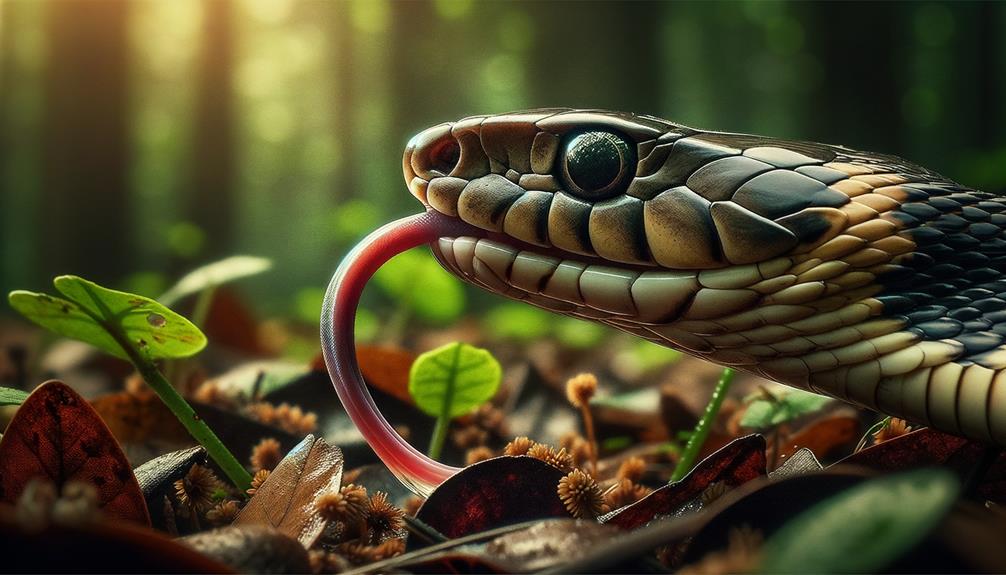Snakes have a remarkable ability to sense their surroundings, thanks to their unique forked tongues. This split-tipped organ serves as a powerful tool for gathering scent particles from both the air and ground. Each prong of the tongue collects these particles and transfers them to a specialized structure called Jacobson's organ, which processes the chemical signals.
This setup allows snakes to effectively "smell in stereo," giving them the ability to determine both the direction and intensity of various scents. As a result, snakes can locate prey and navigate their environment with impressive accuracy. When a snake flicks its tongue, it creates small air currents that concentrate scent molecules, further enhancing their detection capabilities.
The efficiency of this sensory system is truly remarkable. Even faint odors can be picked up and analyzed, giving snakes a significant advantage in their habitats. This adaptation has played a crucial role in their survival and success as predators.
As we continue to study these fascinating creatures, we're constantly learning more about how their sensory systems work and how they've evolved over time. The snake's tongue is just one example of the many ways nature has developed sophisticated solutions to environmental challenges.
Anatomy of Snake Tongues
Snake tongues are fascinating organs that constantly flick in and out, designed with split tips that greatly improve their ability to collect and process smells. These tips cover a wider area, giving snakes an edge in sensing their environment. The tongue fits perfectly into a specially shaped groove on the roof of the mouth, making it easy to transfer scent particles to special smell-detecting organs.
The split tips of the tongue have tiny openings where saliva flows, trapping scent particles from the air. This clever design is key for moving these particles to the smell-detecting organs in the mouth's roof. These organs are packed with cells that act like super-sensitive smell detectors, able to pick up even the faintest scents.
Once scent particles reach these special organs, the snake's brain compares information from the left and right sides of the tongue. This comparison helps the snake quickly determine where a smell is coming from, making it an effective hunter. The precision and efficiency of this forked tongue system are truly impressive.
How Snakes Use Their Tongues

Snakes have a unique way of sensing their surroundings. They use their split tongues to pick up scent particles from the air and ground. Each side of the tongue, called a tine, gathers these smells and sends them to special organs in the snake's mouth for processing.
When a snake flicks its tongue, it creates tiny swirls of air that concentrate scent molecules. This makes the tongue incredibly good at collecting smells. Snakes can actually smell in stereo, comparing scents from the left and right sides of their tongue. This ability helps them figure out where smells are coming from and how strong they are.
Snakes use their tongues for several key tasks:
- Gathering scents from their environment
- Creating air swirls to concentrate smells
- Processing scent information
- Finding and following prey
This remarkable sense helps snakes navigate their world, find food, and stay safe from threats. It's a fascinating example of how animals have adapted to thrive in their environments.
Role of Jacobson's Organ

Snakes have a remarkable way of understanding their environment through scent. The key to this ability is Jacobson's organ, also called the vomeronasal organ, which works hand-in-hand with their forked tongues.
When a snake sticks out its tongue, it's not just tasting the air – it's collecting tiny scent particles from its surroundings. This behavior is particularly useful for snakes on the hunt. The tongue then brings these particles back to Jacobson's organ, located in the roof of the snake's mouth.
This unique organ is highly sensitive to pheromones and other chemical signals. It allows snakes to interpret complex information about their environment. The process involves several steps:
- The snake flicks its tongue to gather scent particles.
- The tongue touches Jacobson's organ, depositing the particles.
- Sensory cells in the organ are activated, processing the chemical signals.
- The brain receives and interprets this scent information.
Through this process, snakes can detect potential prey, avoid predators, and even find mates. It's a sophisticated system that has evolved over millions of years, giving snakes an edge in their diverse habitats.
Tracking Prey With Tongue Flicks

Snakes are expert hunters, using their tongues to track prey with remarkable accuracy. Their split tongues, with two fine points called tines, gather scents across a broader area. Each tine collects distinct smell signals, giving snakes a 3D olfactory map. This allows them to pinpoint their prey's location more precisely than many other predators with just one flick.
In a single second, a snake's tongue moves up and down 15 times, creating small air swirls that concentrate scent molecules. This quick action ensures the snake gets a strong whiff, leading to fast and precise tracking. The brain then processes the information from both tines to zero in on the prey's exact spot.
Studies show that snakes outperform their lizard relatives in scent collection, showcasing their unique environmental adaptation.
Key points:
- Split tongues: Broaden scent collection area
- 3D smell mapping: Helps locate direction and distance
- 15 flicks per second: Boosts scent capture
- Air swirls: Concentrate odors for better detection
This advanced smell system makes snakes highly effective hunters, perfectly suited to track down prey with razor-sharp accuracy.
Environmental Navigation

Snakes' forked tongues are more than just hunting tools – they're sophisticated navigation aids. Picture a snake winding through a thick forest, its tongue darting out repeatedly. Each flick collects scents from the air and ground, giving the snake crucial info about its surroundings. The tongue's split design lets snakes smell in stereo, comparing scents from left and right.
This dual-scent ability helps snakes pinpoint where smells are coming from, whether it's food or a potential mate. The snake's brain uses these cues to guide it around obstacles, through tight spaces, and across varied terrain. It's especially useful when visibility is poor.
Studies show that even a quick, one-second tongue flick can create 15 up-and-down waves, forming small whirlwinds that concentrate scent molecules. This makes snakes more efficient at picking up smells than many lizards. By focusing these molecules, snakes can better detect pheromones and other important scents, ensuring they don't miss key signals in their environment. This remarkable skill allows them to thrive in complex ecosystems where every move matters.
Frequently Asked Questions
What Is the Purpose of a Snakes' Tongue?
Snakes use their tongues in a way that might surprise you. The forked shape isn't just for show – it's a highly effective tool for gathering scent information. As the snake flicks its tongue, it picks up tiny particles from the air and ground. When the tongue retracts, these particles are transferred to a special organ in the roof of the mouth. The snake's brain then processes this information, creating a detailed picture of its surroundings. This remarkable system helps snakes locate prey, avoid predators, and navigate their environment with precision. It's as if they have a built-in sensory map that's constantly updating.
Why Is the Snake's Tongue Forked?
Snakes have a unique forked tongue that serves a crucial purpose in their survival. This split tongue helps them gather scents from their surroundings more effectively. Each prong of the fork picks up odor particles, which are then sent to special organs in the snake's mouth. By comparing the scents collected on both sides, snakes can accurately pinpoint the location of their prey. This remarkable adaptation allows them to navigate their environment and hunt with precision, even in low-light conditions or when visual cues are limited.
Why Do People Get Snake Tongues?
The notion of humans developing snake-like tongues belongs squarely in the realm of fantasy. In reality, our genetic makeup and physical structure simply don't allow for such a drastic change. While it's an intriguing concept for storytelling or special effects in movies, it's not something that could actually happen to people.
Scientists have studied human anatomy extensively, and there's no biological mechanism that could transform a human tongue into a forked, reptilian one. Our tongues are designed for speech and helping us eat, with taste buds and muscles that serve very specific purposes.
This idea likely stems from folklore or pop culture depictions of shape-shifters or mythical creatures. It's a testament to human imagination, but it remains firmly in the world of make-believe. Medical science continues to advance, but altering fundamental human features to mimic other species isn't on the horizon.
Why Do Snakes Flick Their Tongue When They See Potential Prey?
Snakes use their tongues as sensory tools when eyeing potential meals. By flicking their tongues, they gather tiny scent particles from the air. These particles are then analyzed by special organs in their mouths, known as vomeronasal organs. This remarkable system allows snakes to pinpoint their prey's location with astonishing accuracy, significantly boosting their chances of a successful hunt. It's a clever adaptation that's evolved over millions of years, giving these reptiles a distinct advantage in their environments.



